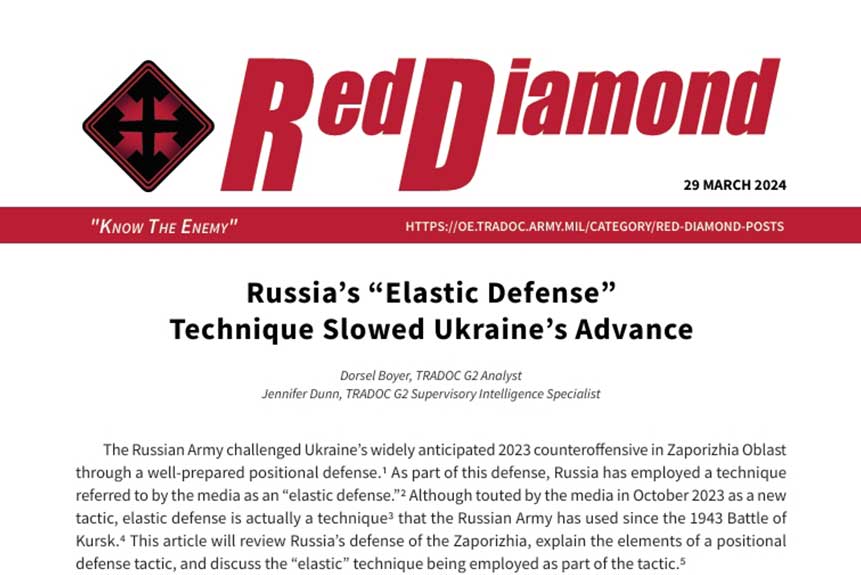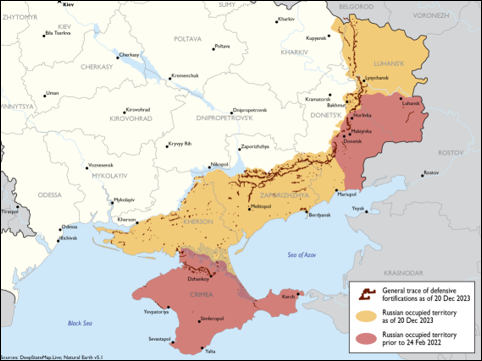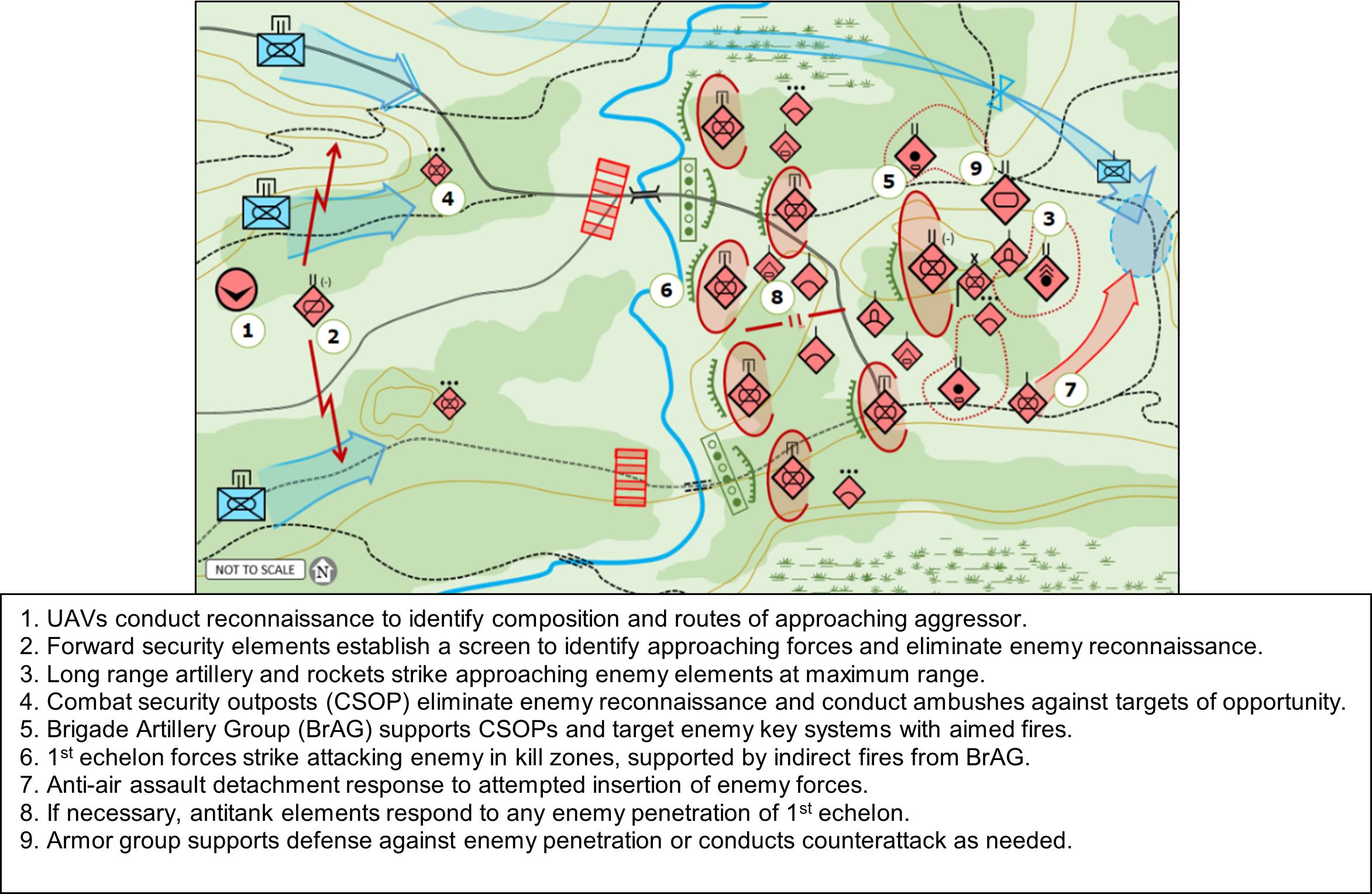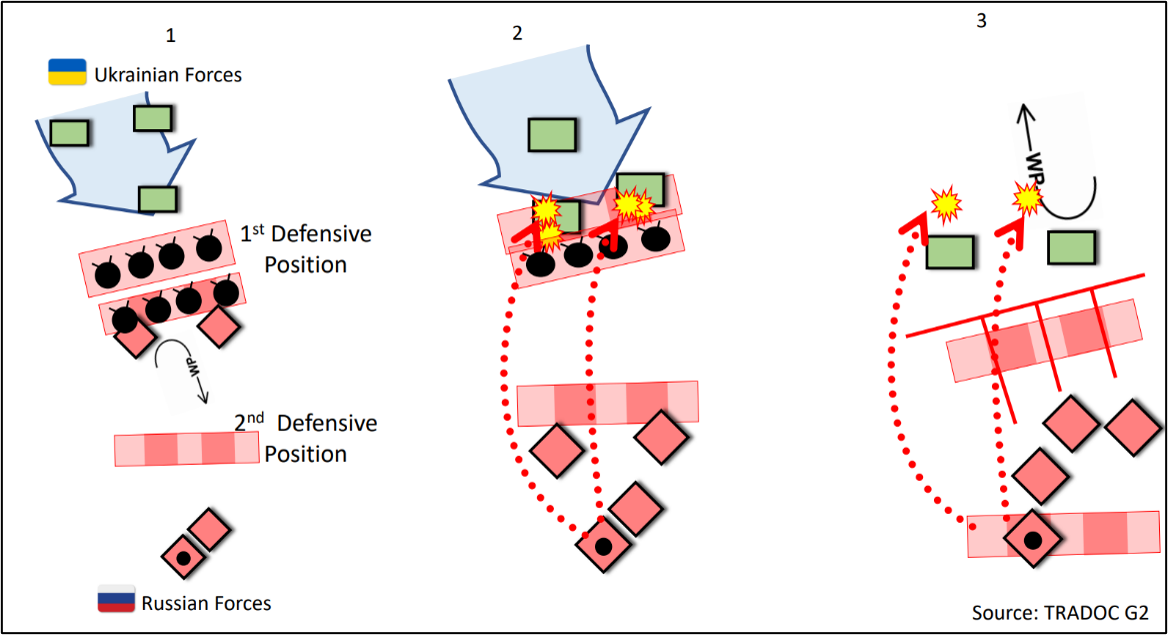
Red Diamond: Russia’s “Elastic Defense” Technique Slowed Ukraine’s Advance
by Dorsel Boyer, TRADOC G2 Analyst and Jennifer Dunn, TRADOC G2 Supervisory Intelligence Specialist
by Dorsel Boyer, TRADOC G2 Analyst
and
Jennifer Dunn, TRADOC G2 Supervisory Intelligence Specialist

Vol. 15, No.1 Winter 2024
The Russian Army challenged Ukraine’s widely anticipated 2023 counteroffensive in Zaporizhia Oblast through a well-prepared positional defense.[i] As part of this defense, Russia has employed a technique referred to by the media as an “elastic defense.”[ii] Although touted by the media in October 2023 as a new tactic, elastic defense is actually a technique[iii] that the Russian Army has used since the 1943 Battle of Kursk.[iv] This article will review Russia’s defense of the Zaporizhia, explain the elements of a positional defense tactic, and discuss the “elastic” technique being employed as part of the tactic.[v]
In Zaporizhia, elastic defense has denied the Ukrainian military the ability to concentrate forces and consolidate and exploit gains in the offense. Russia’s defense of the Zaporizhia Oblast is using prepared defensive positions established immediately after Ukraine’s 2022 counteroffensive in Kharkiv. These defensive positions are known as the “Surovikin Line.”[vi] The Surovikin Line is not a singular line but rather several complex belts of defensive positions supported by heavy obstacle belts (see Figure 1).[vii]

Figure 1: Map depicting Russian defensive fortifications
Russia’s defense in Zaporizhia most closely matches what their doctrine refers to as a “positional defense.” The strongest indicators of this are the well prepared, nearly contiguous fighting positions supported by planned artillery and dense mine and obstacle belts.[viii] A positional defense, in Russian doctrine and in Zaporizhia, is designed to exact the utmost losses on the aggressor by holding prepared defensive positions. The positional defense is used to defend critical terrain and significant objectives considered too important to lose to the aggressor. Typically, a Russian positional defense will be significantly echeloned by a system of defensive positions, lines, and areas, and a prepared system of planned and integrated fires designed to defeat the aggressor. (See Figure 2 for a doctrinal example of how Russia would execute a positional defense.)

Figure 2: Example of Russian Brigade Tactical Group positional defense
Russia was not using the ‘elastic defense’ technique in the early stages of Russia’s positional defense in Zaporizhia. Russia’s defense was initially successful and able to stymie Ukraine’s advance with planned artillery kill zones, supported by obstacles and aviation. Russia’s defense did not require any limited counterattacks as seen with the elastic defense technique because Ukraine was not able to advance.
However, in October of 2023, Russia’s technique changed and began using elastic defense to counter Ukraine’s incremental gains from its summer 2023 offensive. For elastic defense, Russian forces tactically withdraw to prepared secondary fighting positions while Ukrainian forces continue their advance (see Figure 3). As the Ukrainian ground forces are drawn into the first Russian position, a combination of mines, improvised explosive devices, and preplanned artillery fires attrit their forces. Once the mines or other explosive hazards detonate and the preplanned fires lift, Russian reserves conduct limited counterattacks with local reserves to dislodge Ukrainian troops and regain the original position.[ix]

Figure 3: Russian ‘elastic defense’ sequence
Elastic defense allows Russian forces to capitalize on the speed and aggression of Ukrainian forces attacking into a kill zone. Russian forces rapidly counterattack to dislodge them before gains can be consolidated. Simultaneously, the Russian tactical withdraw preserves forces for the defense. The use of this technique relies heavily on the ability of trained second echelon forces and careful timing and coordination. Russian use of airborne and naval infantry in western Zaporizhia indicates that higher quality forces are available to support the elastic defense technique.
Russia’s use of elastic defense in Zaporizhia has significantly slowed Ukraine’s counteroffensive. Ukraine, unable to consolidate gains, has had little success at breaking through Russia’s defenses in Zaporizhia and has not reclaimed a significant amount of territory from Russia. Russia’s well prepared defensive positions, combined with the use of obstacles and the prevalence of drone use, have set the conditions to allow for the successful employment of this operational technique.
Implications for the U.S. Army
U.S. Army forces should anticipate the use of limited tactical maneuver by a defending enemy and be aware of the tools at its disposal to counter the elastic defense technique.
- Collection plans could consider the use of intelligence, surveillance, and reconnaissance assets to identify possible secondary enemy fighting positions.
- Once identified, planned fires may suppress the enemy’s secondary positions while friendly forces consolidate captured positions. The effectiveness of this technique hinges on the ability of the defender to counterattack while the attacking force is reacting to mines, other explosive hazards, or fires on the objective.
The OPFOR could simulate this type of tactic during rotational training events at combat training centers.
- The OPFOR could prepare carefully selected secondary positions and intentionally cede ground to the rotational training unit. It could then call for preplanned fires and initiate command- or victim-detonated mines on ceded positions.
- The OPFOR also could launch immediate counterattacks to regain the initial position while inflicting maximum casualties on the rotational training unit.
[i] Charles Bartles and Lester Grau, “Defense,” essay, in The Russian Way of War, 1.2 (Leavenworth, KS: U.S. Army Foreign Military Studies Office, 2017), 74–115.
[ii] Elastic Defense as defined by recent press reporting highlights the use of secondary fighting positions that allow Russian defenders to displace and rapidly conduct a local counterattack to regain their original position.
[iii] Tactics are the employment and ordered arrangement of forces in relation to each other. Techniques are non-prescriptive ways or methods used to perform missions, functions, or tasks.
[iv] Matthew Mpoke Bigg, “Russian Troops Cede Ground and Strike Back, Frustrating Ukraine’s Counteroffensive,” The New York Times, October 3, 2023, hxxps://www.nytimes.com/2023/10/03/world/europe/russia-ukraine-elastic-defense-counteroffensive.html.
[vi] The Surovikin line is named for Sergey Surovikin, the Russian general who commanded the Southern grouping of Russian forces for the initial invasion into Ukraine and become the commander of all Russian forces in Ukraine in from October of 2022 until September 2023.
[vii] Jake Epstein, “Ukraine’s Front-Line Forces Are Trying to Fight Their Way through Russia’s Formidable Surovikin Line. Here’s What That Is.,” Business Insider, September 6, 2023, hxxps://www.businessinsider.com/ukraine-front-line-forces-fighting-through-russia-surovikin-line-2023-9.
[viii] Charles Bartles and Lester Grau, “Defense,” essay, in The Russian Way of War, 1.2 (Leavenworth, KS: U.S. Army Foreign Military Studies Office, 2017), 74–115.
[ix] Angelica Evans et al., “Russian Offensive Campaign Assessment, October 1, 2023,” Institute for the Study of War, October 1, 2023, hxxps://www.understandingwar.org/backgrounder/russian-offensive-campaign-assessment-october-1-2023.
References
Bartles, Charles, and Lester Grau. “Defense.” Essay. In The Russian Way of War, 1.2ed. 74–115. Leavenworth, KS: U.S. Army Foreign Military Studies Office, 2017.
Bartles, Charles, and Lester Grau. “The Russian Army and Maneuver Defense.” Earmor. Spring 2021. https://www.moore.army.mil/Armor/eARMOR/content/issues/2021/Spring/.
Bigg, Matthew Mpoke. “Russian Troops Cede Ground and Strike Back, Frustrating Ukraine’s Counteroffensive.” New York Times. October 3, 2023. hxxps://www.nytimes.com/2023/10/03/world/europe/russia-ukraine-elastic-defense-counteroffensive.html.
Epstein, Jake. “Ukraine’s Front-Line Forces Are Trying to Fight Their Way through Russia’s Formidable Surovikin Line. Here’s What That Is.” Business Insider. September 6, 2023. hxxps://www.businessinsider.com/ukraine-front-line-forces-fighting-through-russia-surovikin-line-2023-9.
Evans, Angelica, Nicole Wolkov, George Barros, Karolina Hird, and Frederick W Kegan. “Russian Offensive Campaign Assessment, October 1, 2023.” Institute for the Study of War. October 1, 2023. hxxps://www.understandingwar.org/backgrounder/russian-offensive-campaign-assessment-october-1-2023.
DISTRIBUTION A: APPROVED FOR PUBLIC RELEASE; DISTRIBUTION IS UNLIMITED
Distribution A: Approved for public release
Categories:
Tags:
Red Diamond: Russia’s “Elastic Defense” Technique Slowed Ukraine’s Advance
by Dorsel Boyer, TRADOC G2 Analyst and Jennifer Dunn, TRADOC G2 Supervisory Intelligence Specialist
File Size:
820 KB
File Type:
Page Count:
5

